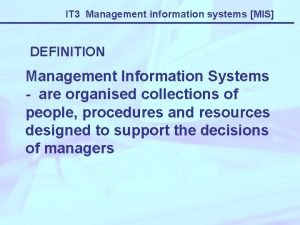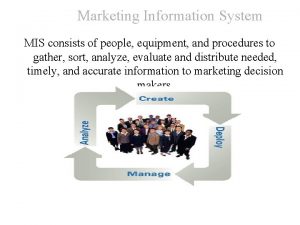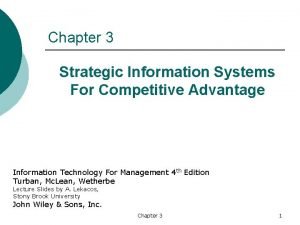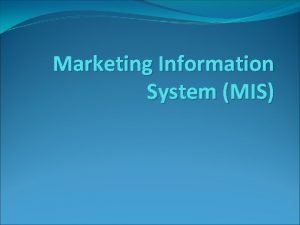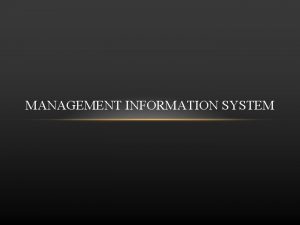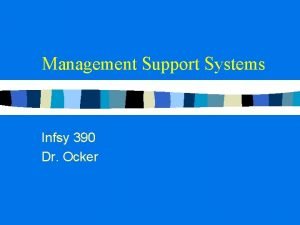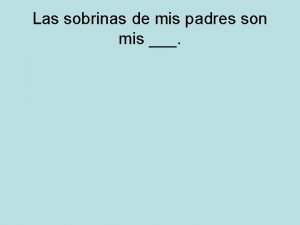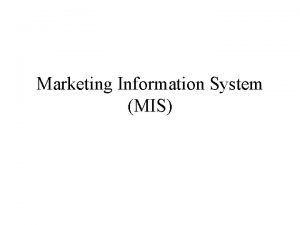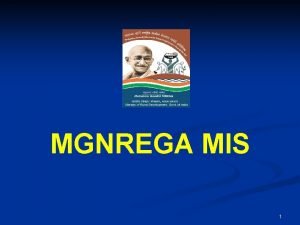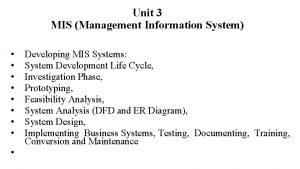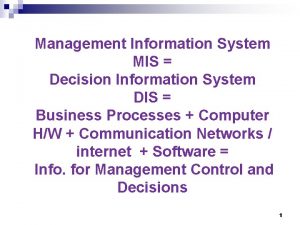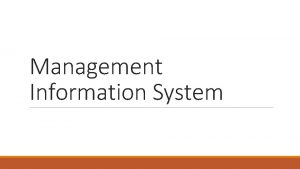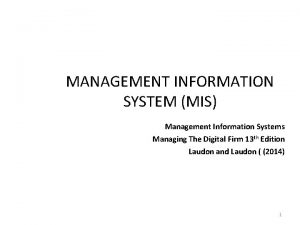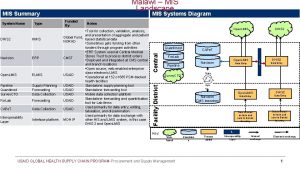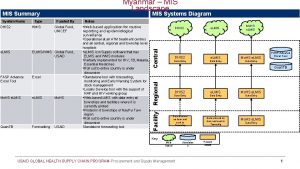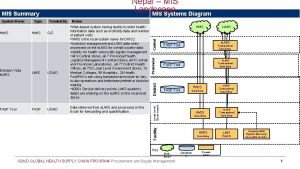Management Information System MIS MIS is short for












- Slides: 12


Management Information System (MIS

MIS is short for management information system or management information services. Management information system, or MIS, broadly refers to a computer-based system that provides managers with the tools to organize, evaluate and efficiently manage departments within an organization. In order to provide past, present and prediction information, a management information system can include software that helps in decision making, data resources such as databases, the hardware resources of a system, decision support systems, people management and project management applications, and any computerized processes that enable the department to run efficiently.

to gather, integrate, compare, analyze, and disperse information ( The MIS has more than one definition, some of which are given below: 1. The MIS is defined as a system which provides information support for decision making in the organisation. 2. The MIS is defined as an integrated system of man and machine for providing the information to support the operations, the management and the decision making function in the organization. 3. The MIS is defined as a computer based information System.

Characteristics of MIS • Management Oriented. • Management directed. • Integrated. • Common data flows. • Heavy planning element. • Sub system concept. • Common database. • Computerised. • Flexibility and Ease of use.

• Management Oriented : It means that effort for the development of the information system should start from an appraisal of management needs and overall business objectives. • Management directed : Because of management orientation of MIS, it is necessary that management should actively direct the system’s development efforts. • Integrated : Development of information should be an integrated one. It means that all the functional and operation information sub-system should be tied together into one entity. An integrated information system has the capability of generating more meaningful information to management.

• Common data flows : It means the use of common input, processing and output procedure and media whenever possible is desirable. Data is captured by system analysts only once to its original source as possible. They, then, try to utilise a minimum of data processing procedure and sub-system to process the data and strive to minimise the number of output documents and reports procedure by the system. • Heavy planning element : An MIS usually takes 3 to 5 years and sometimes even longer period to get established firmly within a company. Therefore, a heavy planning element must be present in MIS development. • Sub system concept : Even though the information system is viewed as a single entity, it must be broke down into digestible sub system which can be implement one at a time by developing a phasing plan.

• Common database : Database is the mortar that holds the functional system together. It is defined as a “superfile” which consolidates and integrates data records formerly stored in many separate data file. • Computerized : It is possible to have MIS without using computer. But use of computer increase the effectiveness of the system. • Flexibility and Ease of use : While building an MIS system all types of possible meaning which may occur in future added to make it flexible.

Components of MIS • Data Capturing. • processing of Data. • Storage of Information. • Retrieval of Information. • Dissemination of MIS.

• Data Capturing : MIS capture data from various internal and external sources of an organization. • Processing of Data : The captured data is processed to convert it into required management information. Processing of data is done by such activities as calculation g, comparing, sorting, classifying and summarising. • Storage of Information : MIS stores processed or unprocessed data for future use. If any information is not immediately required, it is saved as an organisational record.

• Retrieval of Information : MIS retrieves information from its stores as and when required by various users. As per the requirements of management users, the retrieved information is either disseminated as such or it is processed again to meet the exact MI demands. • Dissemination of MI : Management information , which is a finished product os MIS, is disseminated to the users in the organization. It could be periodic, through reports or online through computer terminals.

THANK YOU
 Tall + short h
Tall + short h What is management information systems
What is management information systems Mis meaning
Mis meaning Mis equipment
Mis equipment Strategic information system advantages
Strategic information system advantages Marketing information system meaning
Marketing information system meaning A marketing information system mis consists of
A marketing information system mis consists of Management support system
Management support system Misión proyecto de vida
Misión proyecto de vida El hermano de la hija del tío de mi padre es mi
El hermano de la hija del tío de mi padre es mi Mis mai a mis tachwedd
Mis mai a mis tachwedd Mis mai a mis tachwedd
Mis mai a mis tachwedd Mis actos son un reflejo de mis creencias
Mis actos son un reflejo de mis creencias


